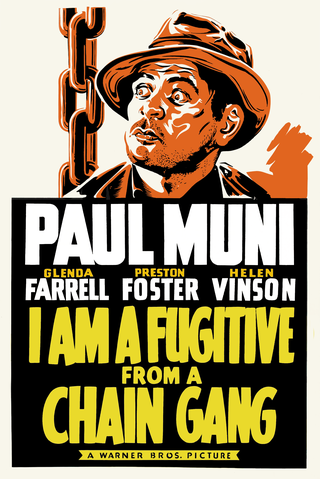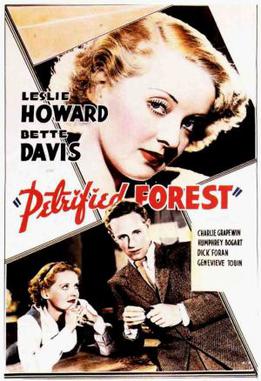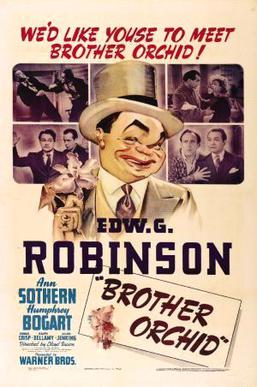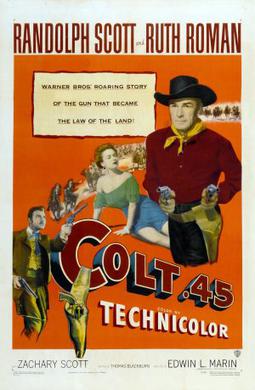
I Am a Fugitive from a Chain Gang is a 1932 American pre-Code crime-drama film directed by Mervyn LeRoy and starring Paul Muni as a wrongfully convicted man on a chain gang who escapes to Chicago. It was released on November 10, 1932. The film received critical acclaim and was nominated for three Academy Awards including Best Picture and Best Actor for Muni.

Angels with Dirty Faces is a 1938 American crime drama film directed by Michael Curtiz for Warner Brothers. It stars James Cagney, Pat O'Brien, The Dead End Kids, Humphrey Bogart, Ann Sheridan, and George Bancroft. The screenplay was written by John Wexley and Warren Duff based on the story by Rowland Brown. The film chronicles the relationship of the notorious gangster William "Rocky" Sullivan with his childhood friend and now-priest Father Jerry Connolly. After spending three years in prison for armed robbery, Rocky intends to collect $100,000 from his co-conspirator Jim Frazier, a mob lawyer. All the while, Father Connolly tries to prevent a group of youths from falling under Rocky's influence.

The Petrified Forest is a 1936 American crime drama film directed by Archie Mayo and based on Robert E. Sherwood's 1934 drama of the same name. The motion picture stars Leslie Howard, Bette Davis and Humphrey Bogart. The screenplay was written by Delmer Daves and Charles Kenyon, and adaptations were later performed on radio and television. The film is set in Petrified Forest National Park in Arizona.

High Sierra is a 1941 American film noir directed by Raoul Walsh, written by William R. Burnett and John Huston from the novel by Burnett, and starring Ida Lupino and Humphrey Bogart. Its plot follows a career criminal who becomes involved in a jewel heist in a resort town in California's Sierra Nevada, along with a young former taxi dancer (Lupino).

Key Largo is a 1948 American film noir crime drama directed by John Huston and starring Humphrey Bogart, Edward G. Robinson and Lauren Bacall. The supporting cast features Lionel Barrymore and Claire Trevor. The film was adapted by Richard Brooks and Huston from Maxwell Anderson's 1939 play of the same name. Key Largo was the fourth and final film pairing of actors Bogart and Bacall, after To Have and Have Not (1944), The Big Sleep (1946), and Dark Passage (1947). Claire Trevor won the 1948 Best Supporting Actress Academy Award for her portrayal of alcoholic former nightclub singer Gaye Dawn.

The Enforcer is a 1951 American film noir co-directed by Bretaigne Windust and an uncredited Raoul Walsh, who shot most of the film's suspenseful moments, including the ending. The production, largely a police procedural, stars Humphrey Bogart and is based on the Murder, Inc. trials. The supporting cast features Zero Mostel and Everett Sloane.

Each Dawn I Die is a 1939 gangster film directed by William Keighley and starring James Cagney and George Raft. The plot of Each Dawn I Die involves an investigative reporter who is unjustly thrown in jail and befriends a famous gangster. The film was based on the novel of the same name by Jerome Odlum and the supporting cast features Jane Bryan, George Bancroft, Slapsie Maxie Rosenbloom, and Victor Jory.

Colorado Territory is a 1949 American Western film noir directed by Raoul Walsh and starring Joel McCrea, Virginia Mayo, and Dorothy Malone. Written by Edmund H. North and John Twist, and based on the novel High Sierra by W.R. Burnett, the film is about an outlaw who is sprung from jail to help pull one last railroad job.

The Amazing Dr. Clitterhouse is a 1938 American crime film directed by Anatole Litvak and starring Edward G. Robinson, Claire Trevor and Humphrey Bogart. It was distributed by Warner Bros. and written by John Wexley and John Huston, based on the 1936 play The Amazing Dr. Clitterhouse, the first play written by short-story writer Barré Lyndon, which ran for three months on Broadway with Cedric Hardwicke after playing in London.

Crime School is a 1938 American crime drama film directed by Lewis Seiler and starring the Dead End Kids, Humphrey Bogart and Gale Page. It was produced and distributed by Warner Brothers.

Invisible Stripes is a 1939 Warner Bros. crime film starring George Raft as a gangster unable to go straight after returning home from prison. The movie was directed by Lloyd Bacon and also features William Holden, Jane Bryan and Humphrey Bogart. The screenplay by Warren Duff was based on the novel of the same title by Warden Lewis E. Lawes, a fervent crusader for prison reform, as adapted by Jonathan Finn.

The House Across the Bay is a 1940 film directed by Archie Mayo, starring George Raft and Joan Bennett, produced by Walter Wanger, written by Myles Connolly and Kathryn Scola, and released by United Artists. The supporting cast features Lloyd Nolan, Walter Pidgeon and Gladys George.

Brother Orchid is a 1940 American crime/comedy film directed by Lloyd Bacon and starring Edward G. Robinson, Ann Sothern and Humphrey Bogart, with featured performances by Donald Crisp, Ralph Bellamy and Allen Jenkins. The screenplay was written by Earl Baldwin, with uncredited contributions from Jerry Wald and Richard Macauley, based on a story by Richard Connell originally published in Collier's Magazine on May 21, 1938. Prior to the creation of the movie version of Connell's story, a stage adaptation was written by playwright/novelist Leo Brady. The script was originally produced at Catholic University of America in Washington, DC.

White Heat is a 1949 American film noir directed by Raoul Walsh and starring James Cagney, Virginia Mayo and Edmond O'Brien.

Arthur Raymond "Doc" Barker was an American criminal, the son of Ma Barker and a member of the Barker-Karpis gang, founded by his brother Fred Barker and Alvin Karpis. Barker was typically called on for violent action, while Fred and Karpis planned the gang's crimes. He was arrested and convicted of kidnapping in 1935. Sent to Alcatraz Federal Penitentiary in 1936, he was killed three years later while attempting to escape.
San Quentin is a 1937 Warner Bros. drama film directed by Lloyd Bacon and starring Pat O'Brien, Humphrey Bogart, and Ann Sheridan. It was shot on location at San Quentin State Prison.

Colt .45 is a 1950 American Western film directed by Edwin L. Marin and starring Randolph Scott, Ruth Roman, and Zachary Scott. Reissued under the title Thundercloud, the film served as the loose basis for the television series Colt .45 starring Wayde Preston, which premiered seven years later. Written by Thomas W. Blackburn, author of the lyrics to The Ballad of Davy Crockett, the film is about a gun salesman and gunfighter who tracks down a killer who stole two new Colt .45 repeating pistols leaving a trail of dead bodies behind him. The revolvers used in the movie were actually first model .44 Caliber Colt revolving belt pistols made in 1849 and reaching final form by 1850. Scott correctly demonstrated how to load them so the producers of the film were most likely aware of the anachronism in the title.

Lady Gangster is a 1942 Warner Bros. B picture crime film directed by Robert Florey, credited as "Florian Roberts". It is based on the play Gangstress, or Women in Prison by Dorothy Mackaye, who in 1928, as #440960, served less than ten months of a one- to three-year sentence in San Quentin State Prison. Lady Gangster is a remake of the pre-Code film, Ladies They Talk About (1933). Jackie Gleason plays a supporting role.

The era of American film production from the early sound era to the enforcement of the Hays Code in 1934 is denoted as Pre-Code Hollywood. The era contained violence and crime in pictures which would not be seen again until decades later. Although the Hays office had specifically recommended removing profanity, the drug trade, and prostitution from pictures, it had never officially recommended against depictions of violence in any form in the 1920s. State censor boards, however, created their own guidelines, and New York in particular developed a list of violent material which had to be removed for a picture to be shown in the state. Two main types of crime films were released during the period: the gangster picture and the prison film.

You Can't Get Away with Murder is a 1939 crime drama directed by Lewis Seiler, starring Humphrey Bogart and Gale Page, and featuring "Dead End Kid" leader Billy Halop. The film is from Bogart's period of being cast in B pictures by Warner Bros., before his breakthrough as a leading man in High Sierra two years later. The film is based on the play "Chalked Out" by Lewis E. Lawes.

















